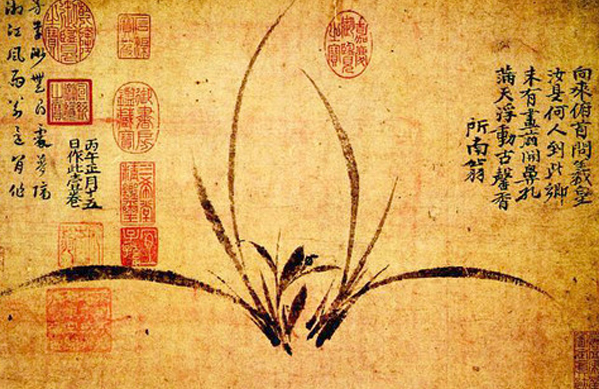Lan: vehicles of Chinese ideas

A lan painting by Zheng Sixiao (1241-1318) kept in Osaka Art Museum in Japan
The lan (orchid), together with mei (plum blossoms), zhu (bamboo) and ju (chrysanthemum), is considered one of the four “gentlemen” flowers. As symbols of elegance, unadornment, nobleness and perseverance, lan flowers have been adored by the Chinese people for more than 2,000 years.
The character “lan” is associated with many good things in Chinese culture. A fabulous article is called a “lan zhang” (lan chapter). The friendship between gentlemen is called “lan you” (lan friendship). The sublime virtue of a person is called their “lan xin” (lan heart).
It is both difficult and elegant to grow lan flowers. What makes a person willing to be a “slave” to a lan is not just the beauty of its outward appearance. The charm of lan manifests in its appearance, fragrance as well as the historical culture and Confucian virtues.
Song (pine trees), zhu (bamboo) and mei are considered three friends one could associate with in winter. However, ancient Chinese said that a bamboo has joints (a symbol of backbone) but no flowers, a plum tree has flowers but no leaves and a pine tree has leaves but no fragrance. Only lan have all these.
According to the Family Sayings of Confucius, associating with virtuous men is like going into a room full of fragrant orchids. Another story of Confucius and lan was recorded by Cai Yong (133-192) in the Qincao, a collection of stories about guqin, a Chinese seven-stringed plucked instrument.
Confucius visited several kingdoms but no one adopted his political ideas. On his way back from Wei to Lu Kingdom, Confucius saw the blooming lan in a deep and secluded valley. He sighed deeply, saying: “Lan should give out fragrance for the King. However, it blooms solitarily among the weeds now. It is like a virtuous man was born in an untimely era and forced to live with superficial and ignorant people.” Confucius then stopped his carriage and composed a guqin song about lan.
This is how lan obtained its reputation as the king’s fragrance or the forbear of fragrance. Confucius is called the “uncrowned king.” The “uncrowned king” sighed at the situation of the unadorned lan in the deserted valley. This sympathy has echoed in the minds of the Chinese people for thousands of years.
Lan has been an eternal subject and image in Chinese culture. It has been the vehicle of expressing emotions and carrier of good virtues that was complimented in almost all forms of artistic and literary expression.
Confucius composed a piece of guqin music to praise lan. Qu Yuan (c.340-c.278 BCE) used lan as a metaphor of good virtues in his most well-known poem Lisao (Encountering Sorrow). Huang Tingjian (1045-1105) wrote calligraphic works chanting lan. Zheng Sixiao (1241-1318) was famous for his black-inked lan paintings. Wang Shizhen (1634-1711), one of the best poets in early Qing Dynasty grew lan as a hobby. Zheng Banqiao (1693-1765), one of the Eight Eccentrics of Yangzhou, painted only three things in his life—lan, bamboo and rocks.
These are just a few examples of lan’s prominence in Chinese culture. Lan is praised for its reserved nature and nobility. Compared with famous flowers such as peonies, lan are inconspicuous in that they are even sometimes mistaken for weeds. Lan also blooms in a low-profile way that the main color of its flowers are green, indistinguishable from its leaves. That is exactly the precious virtue that Chinese people praised lan for—modesty and nobleness. Lan shows us how to keep our genuine internal character and tranquility.
The Confucius classic Great Learning tells us that once the resting point is known, the object of pursuit then is determined. May our heart, following the good model of lan, silently bloom in this noisy mortal life.
